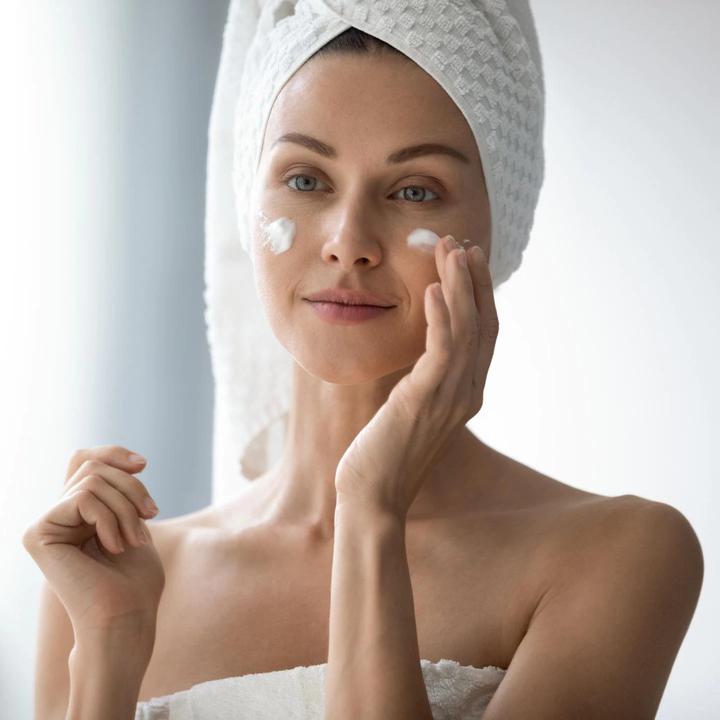
Brown spots appear on the skin as spots, speckles, or larger areas of color. They occur individually or in groups and are clearly distinguished from the surrounding skin tone. There are raised spots, but in many cases the surface remains unchanged and smooth. This distinguishes skin spots (medical macula) from a rash.
Brown spots are most noticeable on the face, hands, arms, legs and décolleté. But the color defects, also known as pigment spots, can appear anywhere on the skin, on the back, chest and stomach, on the ears, on the scalp or in the genital area.
The pigment melanin plays an important role here. If the responsible cells produce too much of it in one place, striking brown tones result. The most common spots of this type include freckles, liver spots, age spots, birthmarks. Sunlight has the greatest influence on melanin formation.
Predisposition, age, metabolism and hormones also have an effect on skin tone from within. For example, some women get brown spots on their faces during pregnancy. Certain medications may also play a role. Some skin diseases such as neurodermatitis sometimes leave behind brown areas after inflammation has healed. In principle, the beginning of skin cancer can be hidden behind dark spots. It is therefore important to show the dermatologist immediately when changes begin (see section "Brown spots: when to see a doctor?").
Disturbed melanin formation is not always the cause. Brown spots can be caused by the smallest bleeding on the legs and then indicate venous insufficiency or inflamed skin vessels. In addition, metabolic disorders, such as those caused by liver disease, sometimes trigger patchy skin changes. Systemic diseases in which several organs become ill or certain hereditary diseases are also possible.
Chemical substances such as silver salts or phenols sometimes also cause brown spots. These can also develop after skin reactions under the influence of sunlight, for example when coming into contact with problem plants such as hogweed. Doctors call such skin changes light eruptions. The skin initially becomes inflamed to varying degrees.
More information on different types of stains and possible triggers can be found in the following sections.
Brown spots: when to see a doctor?
Birthmarks and certain types of moles are often hereditary and mostly harmless, but they can change over the years. In order to recognize malignant developments such as melanoma, black skin cancer, in good time, it is important to always have brown spots assessed by a doctor - as part of the skin cancer screening currently offered, in the event of noticeable changes, but also independently of it.
Observe discolouration caused by sun damage, age-related or hormonal influences. Always show brown spots to the doctor if
If additional symptoms occur, the doctor is also asked. This can be, for example, pain and swelling in the legs, as well as visible varicose veins, joint pain, tiredness and fever.
Often the first point of contact is the family doctor. He will examine you thoroughly and, if necessary, refer you to a skin doctor (dermatologist), sometimes also to a specialist in internal medicine (internist) or a vein specialist (phlebologist) (see the section "Diagnosing brown spots" below).
How brown spots come about
Light brown spots on pale skin that bloom under the summer sun - freckles show quite clearly how much the sun's rays play with our skin tones. Red-haired or blonde women and men in particular experience these changing dot patterns on their skin. In winter, the speckles on the nose, cheeks and arms usually fade or disappear.
But not only the freckles, which are often perceived as cute or attractive, are under the dictates of the sun. Liver spots and age spots also form more frequently if the skin has been exposed to the sun for a long time over the years. That is why dermatologists also speak of lentigines solares ("lens-shaped sunspots") when it comes to age spots. The technical term lentigines usually refers to very different types of liver spots. They can be congenital, such as café-au-lait spots ("milk coffee spots"), or they can form over time.
A birthmark, often called a nevus in technical jargon, is a congenital overgrowth of cells in the skin. There are also different types of birthmarks, depending on which layer of skin and which cells are causing the changes. Liver spots sometimes also belong to the group of nevi.
– Impaired melanin formation
Whether congenital, caused by the sun and other influences or due to illness: when it comes to brown spots, there is always a disorder in the skin structure. The coloring cells in the skin are very often affected. The melanocytes in the epidermis are responsible for the brown tone. They form the pigment melanin and pass it on to neighboring skin cells and the uppermost layers (see graphic). How much melanin the melanocytes produce and how much of it the epidermis cells store is individually designed and characterizes the different skin color types. These range from light-skinned (type 1) to dark-skinned (type 6).
- Color booster number one: The sun
Sunrays directly stimulate the formation of melanin. In order to protect itself from possible attacks by sunlight, the skin stores more melanin in the upper layer. The skin becomes tan. Ultraviolet (UV) rays can also act selectively on melanocytes and damage them in a number of ways. The coloring cells multiply or permanently produce too much dye (pigment). The number of dark spots is increasing, especially on areas of skin that are frequently exposed to light and sun.
Perfumes and preservatives or certain medications, such as those containing St. John's wort extracts, can also increase the skin's sensitivity to light. In combination with the sun, the substances often leave permanent stains, for example on the face, neckline and arms.
Pigment formation and distribution naturally becomes more irregular as we age. In addition to dark areas, there are often white areas. But UV rays intensify this development in old age, or they cause brown spots and moles to appear in the first place.
– Metabolism and hormonal balance affect the skin
The skin structure is also dependent on a balanced metabolism and hormonal balance. Certain hormones, especially the female sex hormones, influence cell activities in the skin. During pregnancy, some women notice yellow-brown spots spread over certain parts of the face. Here, too, the sun sets the tone (see section "Brown spots - Check: Melasma").
- Brown spots caused by skin diseases
The epidermis cells and with them the pigment distribution can be damaged by inflammatory skin diseases. When the inflammation has subsided, brown spots sometimes remain. Possible diseases include neurodermatitis, lichen planus (lichen planus) and advanced psoriasis (see picture). In urticaria pigmentosa, certain tissue cells that are found everywhere in the body and particularly often in the skin are increased (mastocytosis). This disease also causes brownish spots and nodules.
Malignant cell growths are sometimes hidden behind brown spots. The cells multiply and change. Melanin production is increased in the affected area. The stain often changes its appearance. The surface of the skin becomes coarser and the edges fray. Moles and birthmarks can be the basis on which skin cancer, particularly melanoma, develops. Regular check-ups by the doctor are therefore essential. Preliminary stages of a malignant development are, for example, lentigo maligna or a melanotic precancerous condition.

Some hereditary diseases of the skin, such as neurofibromatosis, and so-called systemic diseases can be associated with skin spots. Systemic diseases affect the whole body, but some affect the skin in particular. Sometimes a misguided immune system, which, among other things, attacks the body's own skin cells, plays a role. Such processes can interfere with melanin formation. Other disease processes involve the blood vessels of the skin.
Dark brown spots on the lips and oral mucosa as well as the backs of the hands are sometimes the result of a hereditary disease, the Peutz-Jeghers syndrome. It is often accompanied by intestinal polyps and tumors of internal organs.
– Sometimes visible as brown spots: bleeding and iron-containing blood pigment in the skin
Disturbed melanin production is not always the reason for brown skin spots. The middle layer of skin, the dermis, is traversed by numerous small and medium-sized blood vessels. They also supply the top layer of skin. Dull blows and bumps injure the fine arteries and veins. This causes blood to enter the epidermis. Bruises come in a variety of colors, red-bluish when acute, yellowish-brown when almost gone. Such hematomas show how bleeding and blood deposits in the skin tissue cause color changes that are visible from the outside. The iron contained in the red blood pigment plays an important role in this. If it gets into skin tissue, it changes and finally turns brownish.
Blood vessel diseases such as advanced venous insufficiency set different processes in motion. Blood components leak out or seep into surrounding skin areas. The tissue becomes inflamed. Incipient inflammation is evident in brownish discolored areas, particularly on the lower legs and ankles.
Point or focal bleeding from a vessel into the skin tissue also occurs in a chronic skin disease, purpura pigmentosa progressiva. This is where the finest vessels (capillaries) become inflamed. Characteristic are yellow-brownish to orange spots, which initially appear on both lower legs.
Extensive discoloration of the skin is sometimes the result of metabolic damage. Strictly speaking, these are then often no longer limited spots. If metabolic organs such as the liver or kidneys are diseased, problems can arise when breaking down or excreting certain substances. Iron storage disease, a hereditary metabolic disease, also affects skin pigmentation. Misdirected reactions of the immune system damage the functions of the adrenal cortex in the disease called Addison's disease. If most of these fail, the skin and mucous membranes take on a brown to bronze discoloration. Other symptoms are more important here, however.
The following stain check lists the most important brown stains and possible causes. There you will also find links to further disease guides.
Brown spots - CheckDiagnosis of brown spots
Brown spots must always be assessed by a doctor and checked at regular intervals. This applies regardless of whether the skin discolouration is congenital or develops over the course of life under various influences. For people who have many or very large spots and birthmarks as well as special types of birthmarks, dermatologists recommend close checks, about annually to every six months. The doctor usually discusses the appropriate time interval individually with his patient. Early detection examinations are also important if family members have or have had skin cancer, or if you have had a skin tumor yourself. In addition, the general practitioner also regularly examines the skin every two years as part of the check-ups from the age of 35.
After a detailed doctor-patient discussion and an initial assessment of the spots, the family doctor will refer his patient to a dermatologist depending on the suspicion. If there are indications that the brown spots are part of an internal disease, such as a metabolic disorder or a systemic disease, a specialist in internal diseases (internist) takes on the further diagnosis and treatment. If necessary, he coordinates with a dermatologist. Venous disease specialists are phlebologists.
- Examination by a dermatologist
Important preliminary information - if not already known - for the dermatologist is which medication you are taking, whether you suffer from a specific internal disease, whether you have had skin problems before and whether there are any symptoms such as itching, pain, swelling. He is also interested in questions about previous illnesses in the family, lifestyle, sun protection and handling chemical substances.
The dermatologist will examine all spots all over the body and ask questions about any new or changed spots. The dermatologist often recognizes harmless freckles or moles at first glance. He also examines the nails, the scalp, the lymph nodes, the mucous membranes, for example in the mouth, possibly the genital area and the veins. If necessary, allergy tests are indicated. The doctor also orders blood and urine analyzes from time to time, for example to diagnose a disease such as urticaria pigmentosa.
The dermatologist examines conspicuous spots and developments with a spatula and, if necessary, with the reflected light microscope (dermatoscope). Ultrasound examinations reveal the condition of deeper layers of the skin and can help to detect possible tumor development. They are also an important method for tracking down venous diseases. With the so-called computer-assisted dermatoscopy, the doctor sometimes takes pictures of pigment spots and saves them (photo documentation). This procedure helps to observe, record and analyze suspicious changes with a special program. This allows the doctor to detect black skin cancer and its precursors at an early stage.
Certain tumors, but also infections, for example caused by fungi, can be detected with a special light examination (photodynamic diagnostics, Wood light). In some cases, the dermatologist also uses laser methods, for example when diagnosing tumors or skin inflammation.
A histological examination of tissue samples serves to confirm the diagnosis of certain skin changes. If a melanoma is suspected, the specialist often removes the entire skin mark and has it examined under a microscope.
Treatment of brown spots
Many brown spots and marks are harmless and only pose a cosmetic problem for some of their owners. The number and size of the spots of color are certainly important. A single mole on the cheek or shoulder used to be considered a beauty mark, and quite a few sandy-blonde people see their freckles as a charming addition to nature.
Pronounced stains can often be skilfully covered with concealer. Sometimes bleaching creams and solutions that contain certain acids help. For example, you can tone down the dark areas of color in age spots, melasma or Berloque dermatitis. Dermatologists sometimes also treat Berloque dermatitis or phototoxic reactions with cortisone, for example in the form of ointments or lotions; therapy with tablets may also be indicated.
If age spots or café-au-lait spots are very annoying, the dermatologist can use a special laser procedure to remove them. In this way, discolorations caused by tattoos can be partially reversed or weakened. For the success of laser therapies, however, it is important that the doctor has a lot of experience with the respective method.
Since strong stimuli can lead to dangerous circulatory reactions in urticaria pigmentosa, it is particularly important to avoid possible triggers. These include vigorous skin rubbing, hot baths, or sudden contact with cold water. Anyone affected by this should also have the emergency medication prescribed by their doctor ready to hand, even when they are out and about. In therapy, doctors use antihistamines, special light therapies and other drugs that can relieve the symptoms.
If certain substances or medication have caused the discoloration of the skin, it is also important to avoid triggering factors and to conscientiously comply with protective measures at work. The doctor will change or discontinue a responsible preparation if possible.
Skin cancer is usually treated by specialized dermatologists with surgical interventions and other procedures that are indicated as part of cancer therapy.
If the brown spots are part of a clinical picture such as a skin disease, a venous disease or an internal disease, the focus is on treating the underlying disease. The discolouration often goes away with the therapy. Sometimes, especially with permanent stains, additional dermatological and cosmetic measures can be helpful.
– Essential: sunscreen
Regardless of the cause - anyone who has brown spots must consistently protect themselves from UV radiation. Sun protection is an essential part of any therapy and at the same time the crucial measure to prevent spots and skin cancer.
Prevention begins in childhood. The article "The right sun protection for children" provides information on how best to shield children.
Protect your skin from the sun according to the season and the environment. You can find tips on this on our website (see also the box in the right-hand column). In addition to sunscreen, suitable clothing, such as light shirts, trousers, T-shirts and hats, in particular, keeps harmful UV rays out. It is also important not to go out in the sun during midday, when UV exposure is most intense.
Specialist literature for this guide
Moll I: Dermatology. 7th edition, Stuttgart Georg Thieme Verlag 2010 Altmeyer P: The online encyclopedia of dermatology, venereology, allergology and environmental medicine. Berlin Heidelberg Springer Verlag 2015. Online: http://www.enzyklopaedie-dermatologie.de (accessed on September 21, 2015) Herold G et al.: Internal Medicine, Cologne Gerd Herold 2015 Guideline program oncology (German Cancer Society, German Cancer Aid, Working Group on Dermatological Prevention ): prevention of skin cancer. Guideline 04/2014, awmf Reg.No. 032/052OL. Online: http://www.awmf.org/leitlinien/detail/ll/032-052OL.html (accessed on September 21, 2015)
US National Library of Medicine/Medline Plus: Urticaria pigmentosa. Online: https://www.nlm.nih.gov/medlineplus/ency/article/001466.htm (Accessed 2015-09-21) DermIS Dermatology Information System: Purpura pigmentosa progressiva (pubic mount) (possible triggers): http:// www.dermis.net/dermisroot/de/24815/diagnose.htm (accessed on 09/23/2015)
Specialist editors: Dr. medical Claudia Osthoff







